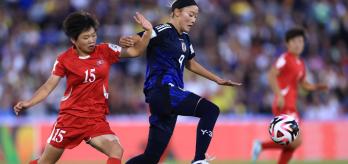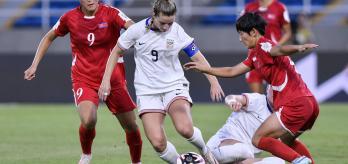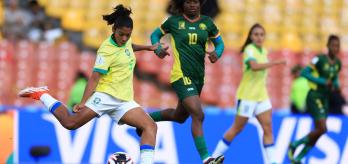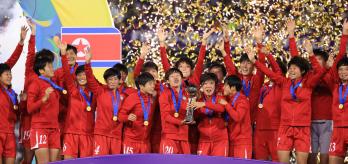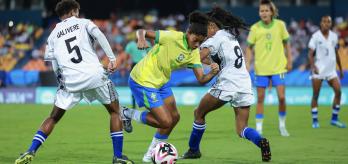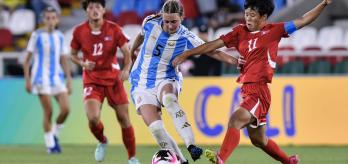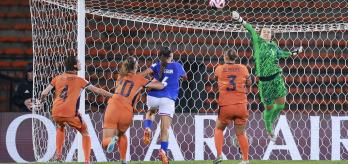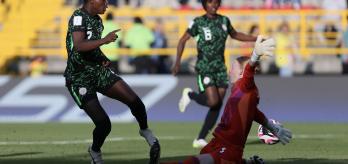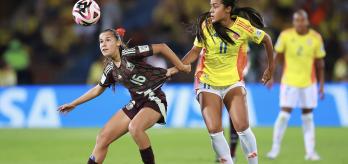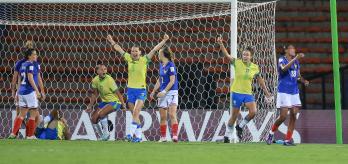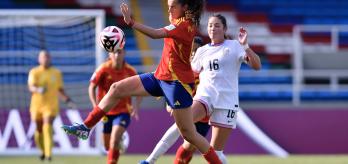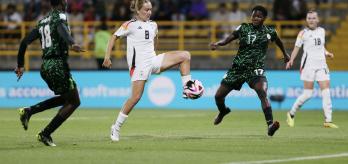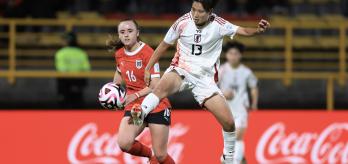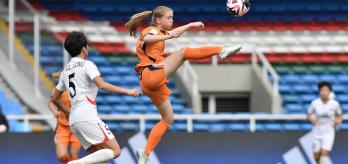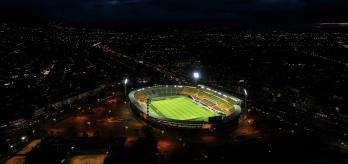Coach Ri Song-ho’s team won all seven matches in regulation time, scoring 25 goals, the second highest goal tally since the USA’s record of 26 in 2002. And with an individual tally of six goals (including the winning goal v Japan in the final), 17-year-old Choe Il-son was the outstanding performer, claiming both the adidas Golden Boot and Golden Ball awards.
According to TSG member Anna Signeul, they were the most consistent team throughout the tournament.
“Both in and out of possession, they proved extremely effective, efficient and incredibly hard-working. They did everything together as a collective and in numbers, from pressing to attacking. They also kept the ball alive for long periods in their games and this was tiring for opposition teams, both physically and mentally. Even when they made substitutions, it did not disturb their rhythm or quality as all players were at such a high level technically and tactically.”
In Possession
Korea DPR consistently dominated the ball in their seven matches, averaging 53.1% possession per game across the tournament, with only Spain averaging higher with 60.5%. They were the third ranked team for possession sequence length, averaging 11.7 seconds per sequence (with only Spain (14.9) and Japan (11.8) ranked higher). In the final, they averaged a staggering 222 possession sequences per 30 minutes in possession compared to Japan (a highly regarded possession-based team) who clocked 181.6 (P30IP).
When they had the ball, they were also very effective at progressing it up the pitch. They averaged a 78.7% success rate for forward passes (ranked third overall behind Spain with 84.3% and Japan with 81.2%) and were the best team overall for progressive pass (forward passes that are >10metres long and take the team closer to the opposition goal) completion rates with 54.4% of those attempted being completed. In addition, they were the most effective team at breaking the last line of the opposition’s defence, completing an average of 15 defensive line breaks per 30 minutes in possession.
The technical attributes and tactical astuteness of Korea DPR’s players were crucial factors in their successes in playing forward so decisively, as Signeul explains. “The ability of their players to read situations to the extent that runs, passes and ball receptions were all made in fast actions and minimal touches was extremely impressive and made them a very difficult opponent for other teams. Due to the constant movements to support every attack, from many players, and how closely they all played together, the player in possession of the ball always had various options to play forward or wide. They wanted to play forward at every available opportunity, but they also knew when to just keep the ball and reset.”
Our Technical Study Group (TSG) have selected three clips below to highlight how these movements and fast football actions gave them the platform to cut through opposition defences.
In clip 1, we see the range of movements and offers to receive that are initiated ahead of the player in possession of the ball. Every time a player receives the ball, new movements and offers are triggered, ensuring the player with the ball always has multiple options to play forward.
In clip 2, we see an example of how the movements to receive can come from players that start behind the player in possession, advancing untracked into space to receive. We also see the speed at which they move the ball and their technical competence at progressing the ball with minimal touches.
In clip 3, we see how passes in Korea DPR’s build-up phase trigger multiple movements ahead of the ball. As soon as the ball is played forward, fast combination passes are played with minimal touches making it difficult for Brazil’s defending players to stop the attacking momentum.
RECEIVING BETWEEN THE LINES
Korea DPR were particularly effective at receiving between the opposition’s midfield and defensive lines. As a team, they ranked fifth overall for receptions between these lines per 30 minutes in possession with 126. When their players were receiving between these lines, 59% of these receptions were under pressure. Forward player Choe Il-son (15) was particularly effective when operating in this space, with an incredible total of eight of her receptions between the opponent’s midfield and defensive lines leading to goals for her team, while 36 led to attempts at goal.
Incredibly, two more Korea DPR players were ranked in joint second for receptions between the midfield and defensive lines that led to goals with Sin Hyang (4) and Jon Ryong-jong (13) both registering seven apiece. The movements of their forward players in relation to the player who was in possession of the ball were fundamental to the successes this team generated from receptions between these lines, as Signeul notes.
“Another impressive feature of Korea DPR’s attacking game was their ability to get players into positions between the lines of opposition’s defensive structures. Their forwards, Choe Il-son (15) and Sin Hyang (4), often dropped in between the midfield and defensive lines while midfielders came from deeper positions to get into these areas also, and even wide players like Jon Ryong-jong (13) drifted inside. They were so effective at creating numerical supremacy in these areas that often players could receive between the lines under no pressure, and even when they were under pressure, they remained competent at receiving and progressing successfully.”
17-year-old Choe Il-son was particularly effective at creating goalscoring opportunities for her team after receiving between the opposition’s midfield and defensive lines and in the two clips below, we see great examples of her movements and technical interactions with the ball when operating in these spaces.
OUT OF POSSESSION
High press and counter-press
A key feature of Korea DPR’s out-of-possession game was their ability to win the ball back when high pressing or counter-pressing. Our TSG members consistently noted their disciplined aggression when operating in these phases as players worked collectively and relentlessly to regain possession. Korea DPR were the second-highest ranked team for the proportion of their out-of-possession time spent in high block with 15.1%, behind the USA on 18.3%. They were also ranked third in the tournament for turnovers in the final third, averaging 12.0 per 30 minutes out of possession.
They were also extremely effective at securing turnovers (tackles and interceptions with possession won) when in the counter-pressing phase with 46.7% success, despite only spending 13.2% of their out-of-possession time in this phase.
When they did not have the ball, they were very quick, aggressive and collective as they engaged to try to regain possession. As Signeul explains, “Against opposition goal kicks, they stepped forward in their 1-4-4-2 structure to high press with each player demonstrating clear knowledge of the roles and responsibilities, understanding when and how to press.
“Their transitions to defend were fast as the player closest to the opposition player in possession was responsible for initiating early pressure. Very quickly, they added numbers to support the press, with Korea DPR players quickly locking onto opposition players who were trying to support the player with the ball.
In the clips below, we see two examples of how Korea DPR won the ball back using a high press. The speed at which they apply the pressure is fundamental to their successes in these situations in addition to the positional awareness they show as they arc their runs to cut off passing options for the player on the ball. As other players attempt to make offers to receive, Korea DPR players respond quickly, demonstrating strong role awareness, to ensure pressure is applied at all stages of the build-up play.
Mid-block/press
If the opposition had controlled possession, Korea DPR quickly assembled into a block. Maintaining their 1-4-4-2 team structure, they were aggressive and close to each other when they defended, winning many second balls and intercepting passes. They were also extremely controlled when applying pressure, with great control and timing in the acceleration and deceleration phases. Their role clarity and ability to read the game meant they could defend on the front foot and win the ball before initiating quick counter-attacks. Examples of this can be seen in the two clips below.
KEY TAKE-AWAYS
Korea DPR were a well-organised team, both in and out of possession, with strong understanding and clarity of roles, regardless of which squad player was playing in each position. Some of the key characteristics of Korea DPR’s victory at the FIFA U-20 Women’s World Cup 2024 included:
- Every player in the squad demonstrated high levels of technical proficiency
- Collective team effort in all phases of the game
- Consistent movements by supporting players to ensure the player in possession of the ball had multiple options to play forward
- Successful at progressing the ball and breaking defensive lines by moving the ball at speed, using minimal touches
- Key movements and offers to receive between the opposition’s midfield and defensive lines resulted in receptions of the ball that led to attempts at goals.
- Out of possession, they operated in collective, aggressive and orchestrated defensive sequences, regardless of the phase they were operating in
- The application of controlled pressure in well-anticipated situations led to high levels of turnovers, interceptions and possession regains.






